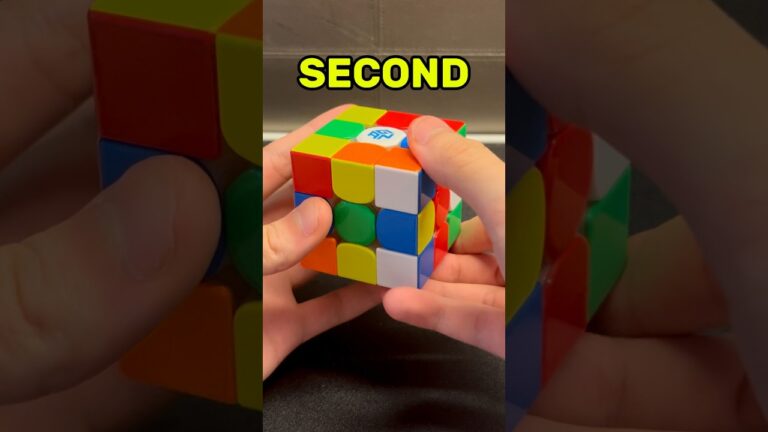[ad_1]
Solving a Rubik’s Cube in under a second is theoretically impossible for humans due to the time it takes for physical manipulation and the brain’s processing speed. The world record is consistently around 3-4 seconds. However, here’s a breakdown of what would be required, assuming near-instantaneous execution:
I. Theoretical Requirements:
A. Perfect Recognition:
-
Instantaneous Pattern Recognition: The solver would need to instantly recognize the entire scrambled state of the cube without any hesitation. This means processing all 54 colored squares simultaneously and understanding their relation to the solved state.
- Subconscious State Evaluation: The solver’s brain would need to instantly evaluate the scramble and choose the most efficient solution path, bypassing conscious thought. This implies an innate understanding of the cube’s state-space and optimal move sequences for every possible configuration.
B. Optimal Algorithm Selection:
-
Pre-programmed Solutions: Possessing a perfect lookup table containing the absolute shortest solution sequence for every possible scramble. This table would need to contain solutions for all 43,252,003,274,489,856,000 possible cube states.
- Flawless Algorithm Application: If not a lookup table, the solver needs an algorithm that always produces the shortest possible solution in real-time. This algorithm would need to analyze the cube’s state and generate the optimal move sequence without any computational delay.
C. Instantaneous Physical Execution:
-
Zero-Latency Hand Movements: The solver would need to be able to execute the required turns with zero time delay between the brain’s signal and the hand’s movement. This would require eliminating all physical limitations of human motor control.
-
Simultaneous Rotations: The ability to rotate multiple layers of the cube simultaneously would significantly reduce the time required. This would require completely independent control of each layer with no physical constraints.
- Perfect Precision: Every rotation must be performed with perfect accuracy, avoiding any misalignments or incomplete turns that would interrupt the solution sequence.
D. Absolute Minimum Move Count (God’s Number):
- Maximum Efficiency: Assuming God’s Number (the maximum number of moves required to solve any scrambled state) is 20 in the Half Turn Metric (HTM) or 26 in the Quarter Turn Metric (QTM), each move would have to be performed in less than 0.05 seconds (1 second / 20 moves HTM) or 0.038 seconds (1 second / 26 moves QTM). This assumes perfect execution.
II. Physical and Cognitive Limitations:
A. Human Reaction Time:
- Neural Processing Delays: Even the fastest human reaction times are significantly longer than the fractions of a second needed. Neural signals take time to travel through the body, and the brain needs time to process information.
B. Motor Control Limits:
-
Muscle Response Time: Muscles cannot contract and move instantaneously. There is a delay between the brain sending a signal and the muscle actually moving.
- Hand Dexterity: Human hands are not capable of the extremely fast and precise movements required for sub-second solving.
C. Cognitive Processing Speed:
-
Information Overload: The human brain cannot process the immense amount of information required to instantly analyze a scrambled cube and calculate the optimal solution path.
- Decision-Making Delays: Even with pre-programmed algorithms, there is a delay in selecting the appropriate algorithm based on the cube’s state.
D. Physical Cube Limitations:
- Cube Mechanics: The cube itself has physical limitations. Friction, inertia, and the speed at which the mechanism can rotate prevent instantaneous turns.
III. What Speedcubers Actually Do:
While sub-second solving is impossible for humans, speedcubers achieve impressive times through:
A. Algorithms:
-
CFOP Method (Fridrich): A popular method involving solving the cube layer by layer (Cross, F2L, OLL, PLL). Speedcubers learn dozens of algorithms (often around 78 for OLL and PLL alone) for specific patterns.
-
Roux Method: A block-building method focused on maintaining certain blocks while solving the rest of the cube.
- ZZ Method: A method that focuses on edge orientation and block building.
B. Look-Ahead:
- Anticipation: Skilled speedcubers anticipate the next steps while executing the current ones, reducing pauses and increasing efficiency.
C. Finger Tricks:
- Optimized Turns: Speedcubers develop finger tricks to execute algorithms quickly and smoothly, minimizing pauses and maximizing efficiency.
D. Cube Setup:
- Tensioning and Lubrication: Properly tensioning the cube and applying lubricant reduces friction, allowing for faster turns.
E. Practice and Muscle Memory:
- Repetition: Thousands of hours of practice develop muscle memory, allowing for near-automatic execution of algorithms.
In conclusion, achieving sub-second solve times on a Rubik’s Cube is beyond human capabilities due to inherent physical and cognitive limitations. Speedcubers achieve impressive solve times through skill, practice, optimized algorithms, and physical cube modifications, but they still operate within the constraints of human reaction time and motor control.
[ad_2]

